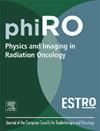一种用于头颈部肿瘤体积分割的交互式深度学习工作流程
IF 3.3
Q2 ONCOLOGY
引用次数: 0
摘要
背景和目的基于深度学习(DL)的头颈癌(HNC)总肿瘤体积自动分割由于解剖学复杂性和有限的准确性仍然具有挑战性。我们提出了一种集成临床医生输入的交互式DL (iDL)工作流,以提高分割性能和临床可用性。利用两个数据集的模拟和一个观察者研究对iDL方法进行了评估。材料和方法开发了两种iDL方法并将其集成到工作流程中:(1)对于原发性肿瘤(GTVt)分割,临床医生标记肿瘤中心并描绘三个正交切片,以便对预训练的3D UNet进行患者特异性微调;(2)对于淋巴结(GTVn),临床医生提供的点击识别相关淋巴结,在单独的UNet中用作注意图。使用聚合骰子相似系数(DSCagg)对内部数据集(n = 204)和HECKTOR 2022数据集(n = 524)进行独立模拟,对方法进行评估。另外一项由三名放射肿瘤学家参与的观察研究,使用标准化的附加路径长度(APL)和系统可用性量表(SUS)评估了可用性和效率。结果iDL工作流获得了较高的分割精度,GTVt的DSCagg为0.84(内部)和0.88 (HECKTOR), GTVn的DSCagg为0.83和0.85。GTVn需要最小矫正(平均APL: 4% vs. 6% vs. 11%);两名观察员对GTVt进行了有限的修正(平均APL: 11% vs. 6% vs. 39%)。平均分割时间为12 min /例。SUS得分范围从87.5到100,表明高可用性。结论iDL工作流程具有较高的准确性和可用性,校正时间短,为放疗中HNC分割提供了实用高效的解决方案。本文章由计算机程序翻译,如有差异,请以英文原文为准。
An interactive deep-learning workflow for head and neck gross tumour volume segmentation
Background and purpose
Deep learning (DL)-based auto-segmentation of head and neck cancer (HNC) gross tumour volumes remains challenging due to anatomical complexity and limited accuracy. We propose an interactive DL (iDL) workflow that integrates clinician input to enhance segmentation performance and clinical usability. The iDL approach was evaluated using simulations on two datasets and an observer study.
Materials and methods
Two iDL approaches were developed and integrated into a workflow: (1) for primary tumour (GTVt) segmentation, clinicians marked the tumour centre and delineated three orthogonal slices to enable patient-specific fine-tuning of a pre-trained 3D UNet; (2) for lymph nodes (GTVn), clinician-provided clicks identified involved lymph nodes used as attention maps in a separate UNet. Methods were evaluated using independent simulations on an internal dataset (n = 204) and the HECKTOR 2022 dataset (n = 524), using aggregated dice-similarity-coefficient (DSCagg). An additional observer study with three radiation oncologists assessed usability and efficiency, using normalized added path length (APL) and the System Usability Scale (SUS).
Results
The iDL workflow achieved high segmentation accuracy, with a DSCagg of 0.84 (internal) and 0.88 (HECKTOR) for GTVt, and 0.83 and 0.85 for GTVn. GTVn required minimal correction (mean APL: 4 % vs. 6 % vs. 11 %); two observers made limited corrections to GTVt (mean APL: 11 % vs. 6 % vs. 39 %). Mean segmentation time was 12 min per case. SUS scores ranged from 87.5 to 100, indicating high usability.
Conclusion
The iDL workflow achieved high accuracy and usability with limited correction time, offering a practical and efficient solution for HNC segmentation in radiotherapy.
求助全文
通过发布文献求助,成功后即可免费获取论文全文。
去求助
来源期刊

Physics and Imaging in Radiation Oncology
Physics and Astronomy-Radiation
CiteScore
5.30
自引率
18.90%
发文量
93
审稿时长
6 weeks
 求助内容:
求助内容: 应助结果提醒方式:
应助结果提醒方式:


